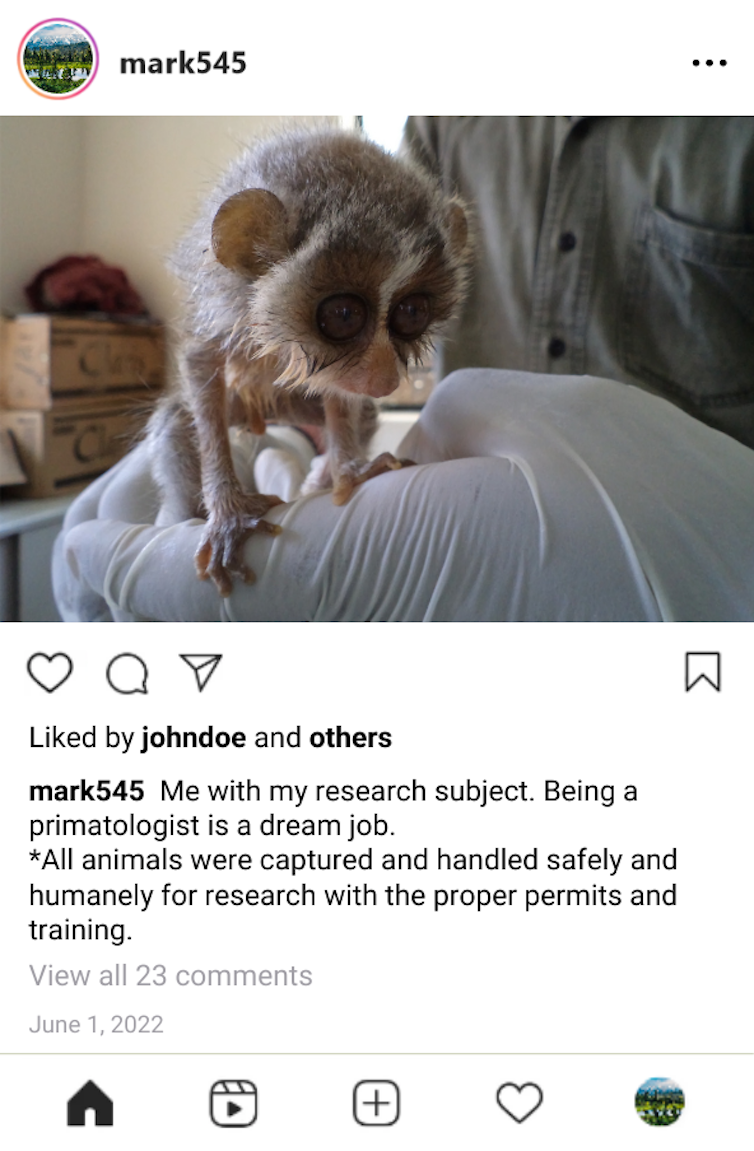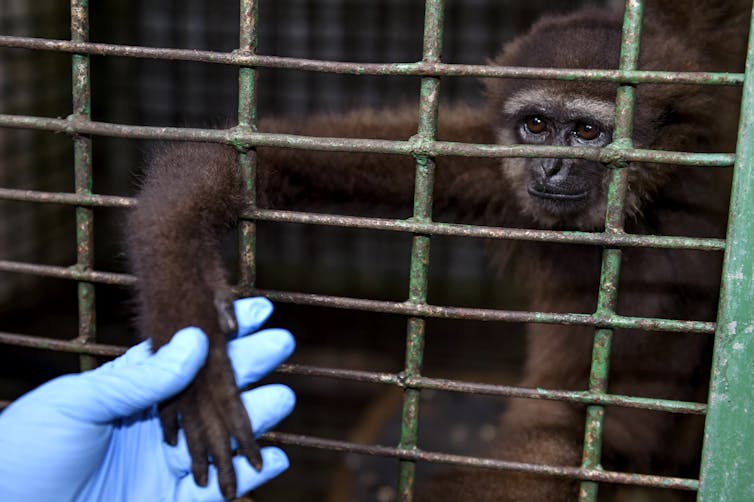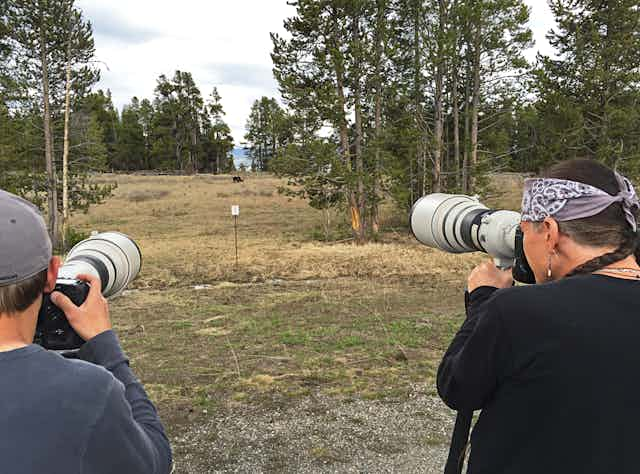One of the biggest privileges of being a primatologist is spending time in remote locations with monkeys and apes, living near these animals in their habitats and experiencing their daily lives. As a 21st-century human, I have an immediate impulse to take pictures of these encounters and share them on social media.
Social media can help scientists raise awareness of the species we study, promote their conservation and obtain jobs and research funding. However, sharing images of wild animals online can also contribute to illegal animal trafficking and harmful human-wildlife interactions. For endangered or threatened species, this attention can put them at further risk.
My research seeks to find ways for scientists and conservationists to harness the power of social media while avoiding its pitfalls. My colleague, ecologist and science communicator Cathryn Freund, and I think we have some answers. In our view, wildlife professionals should never include themselves in pictures with animals. We also believe that featuring infant animals and animals interacting with humans leads viewers to think about these creatures in ways that are counterproductive to conservation.
Show and tell?
Many conservation biologists are thinking hard about what role social media can and should play in their work. For example, the International Union for Conservation of Nature’s Section on Human-Primate Interactions has issued guidelines for how to use images of wild primates and how to conduct primate watching tours.
These guidelines recommend that when scientists show photos of themselves with a wild primate, the caption should state that the person in the image is a trained researcher or conservationist. However, there isn’t much data assessing whether this approach is effective.
We wanted to test whether people actually read these captions and whether informative captions helped curb viewers’ desires to have similar experiences or to own the animal as a pet.
In a study published in 2023, my colleagues and I created two mock Instagram posts – one showing a human near a wild gorilla, the other focusing on a gloved human hand holding a slender loris – a small lemurlike primate native to Southeast Asia. Half of these photos carried basic captions like “Me with a mountain gorilla” or “Me with my research subject”; the other half included more detailed captions that also stated, “All animals are observed” (gorilla) or “captured and handled (loris) safely and humanely for research with the proper permits and training.”

We showed over 3,000 adults one of these mock Instagram posts and asked them to complete a survey. The results shocked us.
Viewers who saw the Instagram posts with the more detailed caption recognized that the picture depicted research. But regardless of the caption, more than half of the viewers agreed or strongly agreed that they would want to seek out a similar experience with the loris or gorilla.
Over half of the viewers agreed or strongly agreed that they would want these animals as pets and that the animals would make good pets. Presumably, participants did not know anything about the animals’ life habits, behavior or survival needs, or that neither of these species is at all suited to be a pet.
Why media impact matters
While these responses may sound merely sentimental or naive, research shows that media – particularly social media – contribute to harmful human encounters with wildlife and to the exotic pet trade.
For example, the Harry Potter films and books, which featured owls as magical creatures used by wizards, led to a sharp increase in the illegal owl trade in Indonesia. Owls once were collectively known in Indonesia as “Burung Hantu,” or “ghost bird,” but now in the country’s bird markets they are commonly called “Burung Harry Potter.”
Studies show that images of people holding lorises drive illegal captures and sales of lorises and other primates. Owners then post further videos showing them handling the animals improperly – for example, tickling the loris, which makes it raise its arms. Viewers see this behavior as cute, but in fact the animals do this to activate toxic glands in their upper arms and move venom to their mouths in preparation to defend themselves.
In earlier research, we found that when orangutan rescue and rehabilitation centers feature baby orangutans and humans interacting with orangutans in YouTube videos, these posts received more views than videos of adult orangutans or orangutans not interacting with people. However, people who watched videos showing infant orangutans, or humans interacting with the animals, posted comments that were less supportive of orangutan conservation. They also stated more frequently that they wanted to own orangutans as pets or interact with them.
Many people who seek out wildlife encounters are not aware of the harm that these experiences cause. Animals can transmit diseases to humans, but it also works the other way: Humans can transmit potentially deadly diseases to wild animals, including measles, herpes viruses and flu viruses.
When humans move through an animal’s habitat – or worse, handle or chase the animal – they cause stress reactions and alter the animal’s behavior. Animals may avoid feeding sites or spend time and energy fleeing instead of foraging.
Owning wild animals as pets is even more problematic. I have worked with several rescue and rehabilitation centers that shelter orangutans formerly kept as pets or tourist attractions. These animals typically are in very poor health and have to be taught how to socialize, move through trees and find their own food, since they have been deprived of these natural behaviors.
The last thing that any responsible conservation biologist studying endangered species wants to do is encourage this kind of human-wildlife contact.

Comment instead of sharing
Many well-meaning researchers and conservationists, along with members of the public, have posted images of themselves near wild animals on social media. I did it too, before I understood the consequences.
Our findings indicate that caption information is not enough to keep people from seeking out animal encounters. As we see it, the answer is for researchers to stop taking and sharing these pictures with the general public.
When scientists create posts, we recommend selecting images that show only wildlife, in as natural a context as possible, or only people in the field – not both together. Researchers, conservationists and the public can go back through their social media history and delete or crop images that show human-wildlife interaction.
Scientists can also reach out to people who post images of humans interacting with wild animals, explain why the images can be harmful and suggest taking them down. Leading by example and sharing this information are simple actions that can save animals’ lives.
Cathryn Freund, director of science communication at the Phillip and Patricia Frost Museum of Science in Miami, contributed to this article.

